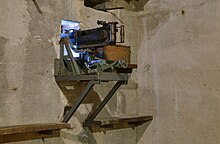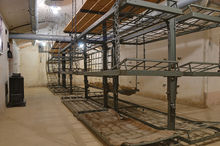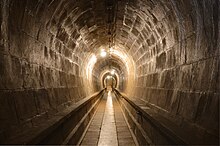Celebrations of Kaiser Wilhelm II.
The fortress Kaiser Wilhelm II. ( French also Fort de Mutzig , formerly Position de Mutzig ) is a fortification built between 1893 and the First World War about 20 kilometers west of Strasbourg in the realm of Alsace-Lorraine , which belonged to the German Empire from 1871 to 1918 . With a circumference of six kilometers, the 254 hectare fortress was the largest closed fortress in the German Empire when the First World War broke out. Between the end of World War I and June 2014, the fortress was officially called Position de Mutzig .
task
After the Franco-Prussian War of 1870/71, parts of Alsace - Lorraine , which had fallen to France since the Peace of Westphalia , became part of the German Empire. In order to secure these areas, the fortresses already built by the French in Metz , Diedenhofen (French: Thionville ) and Strasbourg were expanded. A French attack could have approached Strasbourg mainly from the south, between the natural obstacles of the Vosges and Rhine , or even advanced further west into the Rhine Valley past it. A heavily developed fortress above the city of Mutzig was to act as the right base of a locking bar - the so-called Breuschstellung - between the Vosges and the Rhine. In addition, this blocking fortification of the large Strasbourg fortress was supposed to save time for reinforcement, seal off the Breuschtal and ultimately secure the Molsheim railway junction .
Planning and construction
In almost 25 years the fortress of Kaiser Wilhelm II was built about 200 m above the Breuschtal (French Bruche ), with the villages of Mutzig and Molsheim , on a mountain range divided into four knolls. During this period, the German fortress construction carried out the great change from a single brick fort , in which infantry and artillery still form a unit, up to the modern fortress with concreted infantry rooms that are built separately from the tank batteries . With the Highest Cabinet Order of May 15, 1884, Kaiser Wilhelm I decided to build fortifications near Mutzig. For the time being, the plans did not go beyond a draft. On November 5, 1891, the young Kaiser Wilhelm II , who was already very interested in fortress construction , asked for a final answer to the question of the necessity of the Mutziger facility. From the drafts presented to him shortly afterwards, he opted for the cheaper one with only two forts (east and west). At the same time, he ordered a revision of the plans, as he rejected the intended lunette shape (five-sided, Vaubanian basic shape ) of the forts, preferring instead the more modern triangular shape, as it was created in Belgium by Henri Alexis Brialmont . The final start of construction was ordered on April 28, 1893. In the spring of 1895 the east fort was almost finished. The corresponding west fort was built between 1895 and 1897. Both are built according to the shape desired by the emperor - the Westfort is the only one in the German fortress construction as a pure triangle. In order to document his great interest in the building, the entire complex was given the name Feste Kaiser Wilhelm II on June 14, 1894. For the time being, only limited funds were available for further expansion of the artillery. Which is why in 1898/1899 cheaper but open and only lightly armored umbrella mount cannons (battery 1 at height 375 and batteries 2 and 3 on top of the blot) were built. Due to their position and the high superstructures, these gun emplacements, similar to those of the coastal batteries, were easy for the enemy to see. It was only after the southern wall in Strasbourg had been sold that there was enough money to build a modern, fully armored battery (No. 6) with 4 × 10 cm cannons at 375 between 1904 and 1906. This completed the artillery expansion of the fortress.
To accommodate the teams, three war barracks were built (No. 2 between 1899 and 1901, No. 1 and 3 in 1901/02) and a total of 16 positions with concrete infantry rooms. From 1908 to 1912, a 25 m wide wire barrier was finally built around the fortress. Further extensions and improvements to the infantry positions continued until 1916.
Structure of the plant
Cont
That at a height of 382.4 m above sea level. NHN , built in a triangular shape with a broken right face, is bordered by a 6 m deep trench, which is covered by three trench cuts. Directly in front of the Kehlkaserne , which was to house a company, there are various turret guns (later referred to as Battery 5), watchtowers and an armored observation post. The Westfort was created as an almost equilateral triangle with only two trench lines behind the Blottenspitze at a height of about 390 m. Here, too, the Kehlkaserne forms a unit with the gun emplacement in front of it (Battery 2). The distance between the two core plants is over 900 m.
Armament
- Battery 1 (in the northwest, height 375) with 4 × 10 cm umbrella mount cannons, 80 mm dome armor, total weight 19 t, range 10800 m, rate of fire up to 9 rounds per minute (bpm).
- Battery 2 (in Westfort) with 4 × 15 cm howitzers type 93, 150 mm dome armor made of nickel steel, total weight over 60 t, range 7200 m, rate of fire 2 to 4 bpm.
- Battery 3 u. 4 (on the Blottenspitze, height 390 m) each with 3 × 10 cm umbrella mount cannons.
- Battery 5 (in the east fort) with 4 × 15 cm howitzers Type 93.
- Battery 6 (in the far east, height 374) reinforced with 4 × 10 cm cannons, 150 mm dome armor made of nickel steel, total weight over 60 t, range up to 10800 m, rate of fire 9 bpm.
- 8 vanishing towers (6 in the east and 2 in the west fort) with 5.7 cm rapid-fire cannon for grape ammunition as an assault defense gun, 150 mm dome armor made of nickel steel, total weight approx. 58 t, range 500 m, rate of fire 25 bpm.
- The trench strokes of the two forts were armed with 5.3 cm rapid-fire cannons. This type of gun was also mounted in the Fahrpanzer . Equipped with 40 mm thick armor, they could be used in the positions provided on a transport vehicle with a 60 cm track width as required. The fortress had 16 such armored vehicles with a rate of fire of 25 rounds per minute and a range between 400 and 3000 m.
care
In the fortress there were four power stations with Deutz diesel engines to generate the electrical energy (each in the two forts, in the tank battery (No. 6) and in infantry room 16). The water supply was ensured via four deep wells (in the east fort, for example, 223 m deep) and cisterns . The two forts, the war barracks and most of the infantry rooms were equipped with kitchens and in some cases also with bakeries. Infirmaries with operating theaters were in the war barracks, the infantry rooms were equipped with smaller san wards . Of the three war barracks designed for 1620 men and built into the natural slopes, only the rear fronts are visible. The window openings could be closed with heavy iron shutters. The festival could be operated independently for up to three months.
communication
Externally, the fortress received a telegraph connection to Fort Bismarck in Strasbourg as early as 1893 . In 1902 a radio station was installed in the east fort . Only in 1903/04 was an access road from Sulzbad to the fortress, a second one from Dinsheim in the French period . Within the two forts, the most important parts such as the battery, watchtowers and observation posts were connected to one another by speaking tubes . In 1903 telephone connections were laid in the entire system . Not least because of the rocky subsoil, only a few parts of the facility were connected underground. A corridor connects infantry rooms 1 and 16, and another, 250 m long, connects the tank battery with war barracks No. 3.
Occupation and war effort
Overall, the fortress was designed for a crew of 6500 men. In the event of an alarm, the III. Battalion of the 4th Lower Alsatian Infantry Regiment No. 143 from Mutzig the security crew. At the beginning of the First World War , the Reserve Infantry Regiment No. 60 with 3 battalions, parts of the Baden Foot Artillery Regiment No. 14 from Strasbourg and the 8th Company of the Hohenzollern Foot Artillery Regiment No. 13 from Breisach were transferred to the fortress. The 8th Landsturm-Festungs-Train-Squadron was mobilized to supply the fortress. Only on August 18, 1914, a battery of the Blottenspitze fired 291 shots in the direction of Urmatt ; the fortress was then not involved in any further fighting. In 1917 half of the 10 cm umbrella mounts were dismantled and brought to the front.
After the loss of the First World War, the facility passed into the possession of France, otherwise completely undamaged. A commission of inquiry advocated their inclusion in the planned system of French Rhine defense. In 1940 parts of the 155th RAP (artillery), the 237th RI (infantry) and the 1st Pioneer Regiment were on the fortress. On June 13, 1940 the order was issued to vacate the Rhine position. The fortress was also abandoned a little later and most of the guns made unusable. The German military suspected French troops were still on the site and ordered a Stuka attack by Kampfgeschwader 28. Shortly before, however, the fortress had been occupied by parts of the 215th Infantry Division without a fight. In the air raid that was carried out anyway, over 70 German soldiers died. In November 1944, the 3rd US Infantry Division approached the fortress via the Breuschetal, which was occupied by a few German troops. On November 26th, the facility was surrounded by, among others, E Company, 1st Battalion, 30th US Infantry Regiment. Heavy artillery fire and several air strikes were unsuccessful. The lack of supplies and the hopeless situation then forced the German occupation to give up on December 5, 1944.
The fortress today
After the Second World War , the fortress became a training ground for the French army . Parts of the east fort were filled in in 1947 and the wire obstacle was largely removed. The facility was abandoned in the 1960s, but remained in the possession of the military.
Since the fortress was never seriously contested, it is one of the best-preserved fortress structures in the world from before the First World War . The Germans and French have been restoring the facility since 1984. The first maintenance work began in the north-western section. The accessible areas are now maintained by a Franco-German association. As a result, the fortress is now actively participating in a peaceful European vision. On November 11, 1995, the restored sections were opened to the public as a technology and architecture museum .
The umbrella mount battery 1 and the trench 16 can be visited. On May 1, 2005, an original gun from the umbrella mount battery was fired (built in 1903 Krupp Essen). Two infantry bunkers J1 and J16 are also functional again, i. H. The bakery, kitchens, wells, power generators etc. have been restored. A tour takes about 2 ½ hours. André Brauch's very detailed paintings from the Strasbourg fortresses are also on display. Since June 6, 2014, the fortress has been named after its builder, Kaiser Wilhelm II.
See also
Individual evidence
literature
- Bernard Bour: The feasts of Kaiser Wilhelm II . In: Fortification . Special edition no. 3 , 1996, p. 141-154 .
- Günther Fischer, Bernard Bour: The feasts of Kaiser Wilhelm II . Mutzig 1980 (French edition from 1992).
- Rudi Rolf: The development of the German fortress system since 1870 . Tweede Exloërmond 2000.
Web links
- http://www.fort-mutzig.eu/
- Interior photos of the festivals KW II
- http://www.feste-kaiser-wilhelm.de/
- http://www.jinxed.de/mutzig/index.php3
- High-tech in the green (article in the ZEIT)
Coordinates: 48 ° 32 ′ 52 ″ N , 7 ° 27 ′ 41 ″ E





